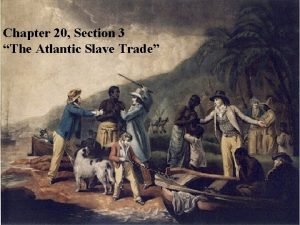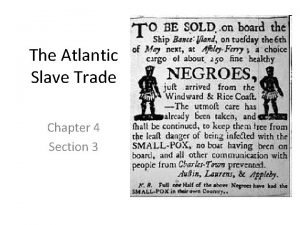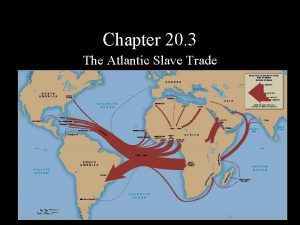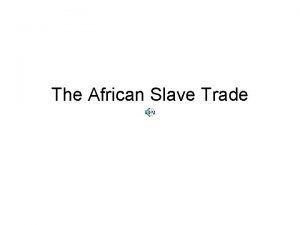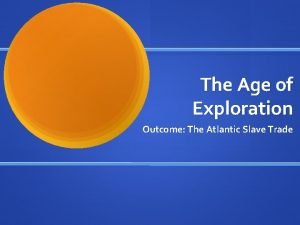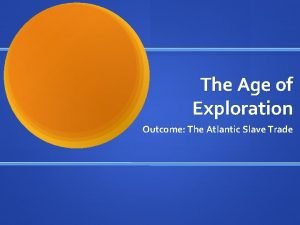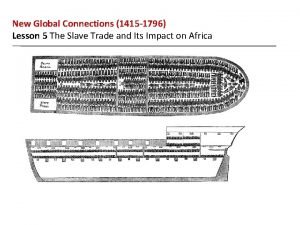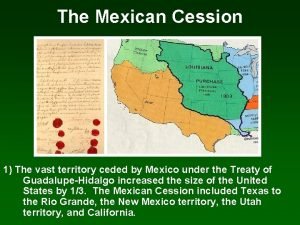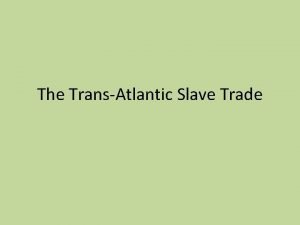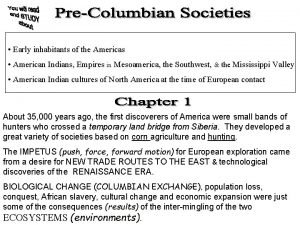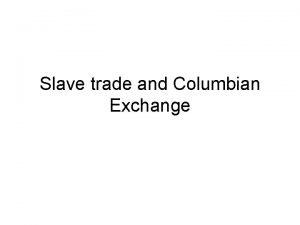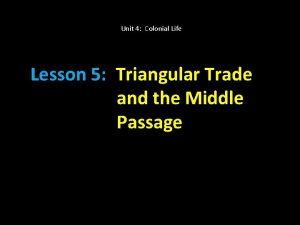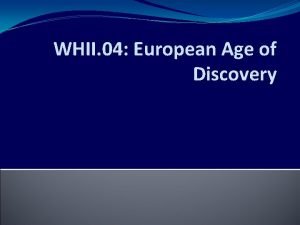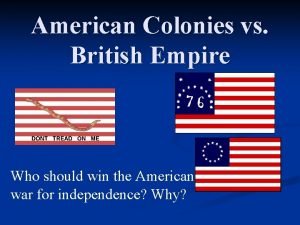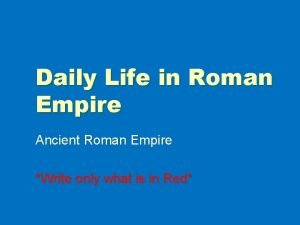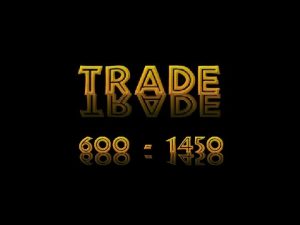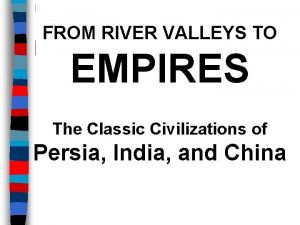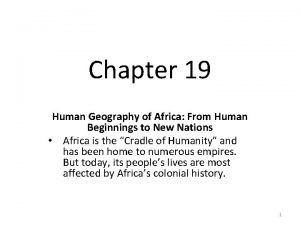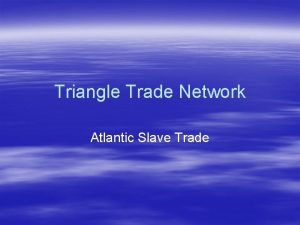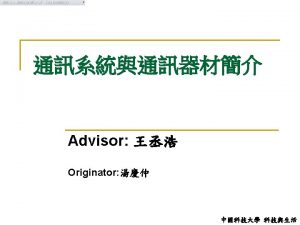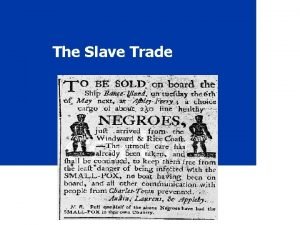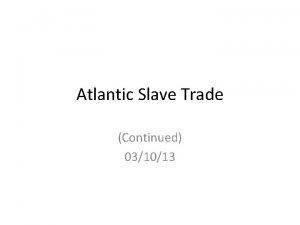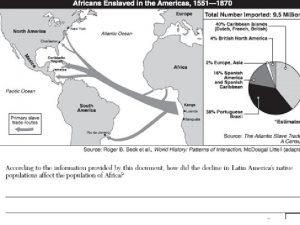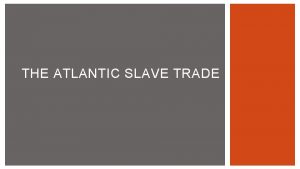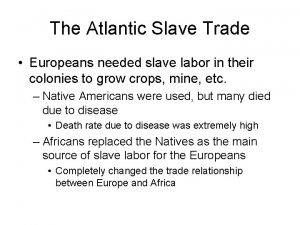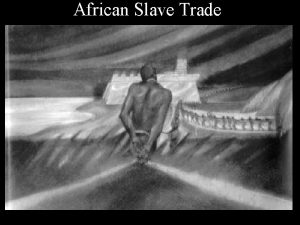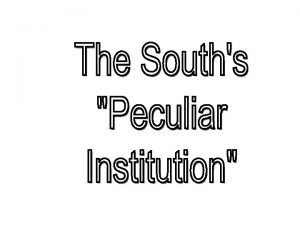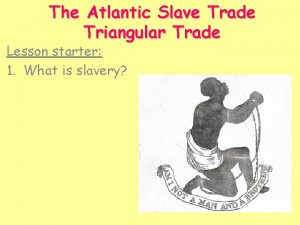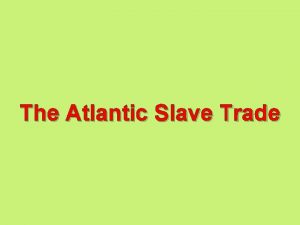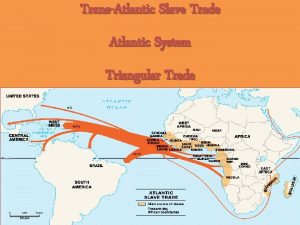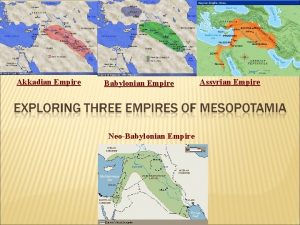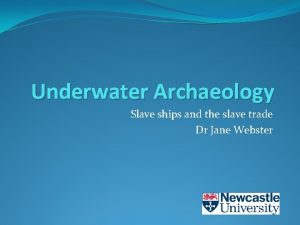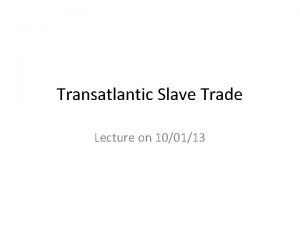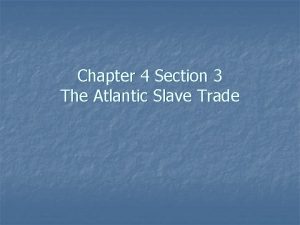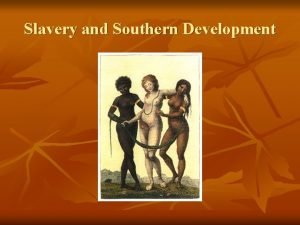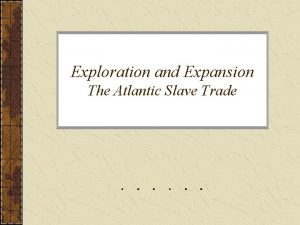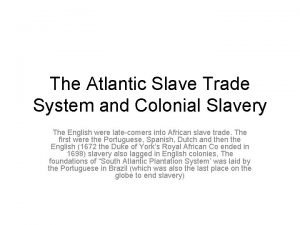CHAPTER 20 Spanish Empire Atlantic Slave Trade and



























- Slides: 27

CHAPTER 20 Spanish Empire, Atlantic Slave Trade, and Columbian Exchange

Columbus � � � 3 ships: Nina, Pinta, Santa Maria Left August 3, 1492 Arrived in ‘San Salvador’ on October 12, 1492


� � � “It was my wish to bypass no island without taking possession” Colonies: Lands that are controlled by another nation Amerigo Vespucci � Map Maker from Italy working for Portugal � Discovers that in fact this was a new world not Asian islands � Later the continent is named after him: Amerigo becomes ‘America’

Hernando Cortes � � Spanish explorer/conquistador lands in Mexico in 1519 Conquistador = Conquerors The Spanish were the first to settle the American continent Cortes conquers the Aztecs, the most powerful empire in Mexico

Montezuma II � � Aztec emperor Believed Cortes was a god at first Spaniards wanted gold Factors leading to Aztec defeat � Superior weaponry � Spanish used the Aztecs enemies against them � Diseases: Measles, mumps, smallpox, and typhus

Spanish Pattern of Conquest � � � In building their new empire they drew inspiration from the Reconquista Most settlers, called peninsulares, were men. Mestizo: Mixed Spanish and Native American Encomienda: a grant by the Spanish Crown to a colonist in America conferring the right to demand tribute and forced labor from the Indian inhabitants of an area The encomienda system allowed natives to be abused by the Spanish…many died



Spanish Empire… � � American colonies make Spain the most powerful nation in the world in the 1500’s. They built the most powerful navy and strengthened other military forces

Spanish North America � � � Ponce de Leon: explored Florida and claimed it for Spain Coronado: led expeditions through Arizona, New Mexico, Texas, Oklahoma, and Kansas Priests complained about conditions for natives and Spain abolished encomienda system which left them with a labor shortage


History of Slavery � � Many scholars believe slavery has existed since the agricultural revolution 10, 000 years ago Slavery has existed in almost every society around the world. Egypt, China, and India have long histories of enslaving people. Slaves were usually came from conquered people. Nationality, Race, and Religion are common factors

The Atlantic Slave trade � � � The Arab and North African Slave trade dates back to 650 AD (book refers to these groups as ‘muslims’) First Europeans during the colonization era to trade for slaves are the Portuguese Between 1500 and 1870 an estimated 9. 5 million Africans had been transported to the Americas

The Atlantic Slave trade � 4 advantages of African slave labor for American colonies: � Africans had been exposed to European and Asian diseases (built up immunities) � Many had farming experience � Less chance of escape in foreign land � They were easy to differentiate from the natives/colonists

Start : 27 stop at 5: 16



� � Triangular Trade: A transatlantic trading network between European nations, African slave traders, and colonies in the Americas Middle Passage: the voyage that brought captured Africans to the West Indies and later to North and South America � Some claim that as many as 20% of slaves died during the journey

Tr

Page 569


Columbian Exchange � � � Definition: the global transfer of foods, plants, disease, and animals. Corn and Potatoes are the two most important American exports due to their high calorie content and being cheap and easy to produce. The world population boomed with the introduction of American food sources and the increased food supply from colonies



Global Trade � � � Capitalism: an economic system based on private ownership and the investment of resources (money) for profit. Inflation: a general increase in prices and fall in the purchasing value of money. Joint-Stock Companies: investors buy shares of stock in a company and limit their risk by diversification.

Global Trade continued � � Mercantilism: a country’s power depends on its wealth. MONEY = POWER Favorable balance of trade: a country sells more goods than it buys
 Chapter 20 section 3 the atlantic slave trade answer key
Chapter 20 section 3 the atlantic slave trade answer key Chapter 4 section 3 the atlantic slave trade
Chapter 4 section 3 the atlantic slave trade The atlantic slave trade chapter 20 section 3
The atlantic slave trade chapter 20 section 3 Atlantic slave trade
Atlantic slave trade Triangular trade definition
Triangular trade definition The age of exploration outcome the atlantic slave trade
The age of exploration outcome the atlantic slave trade The age of exploration outcome the atlantic slave trade
The age of exploration outcome the atlantic slave trade Lesson 5 the slave trade and its impact on africa
Lesson 5 the slave trade and its impact on africa Washington dc slave trade
Washington dc slave trade Transatlantic slave trade pictures
Transatlantic slave trade pictures Effects of the slave trade on africa
Effects of the slave trade on africa Triangular trade apush
Triangular trade apush The transatlantic slave trade
The transatlantic slave trade Slave trade primary sources
Slave trade primary sources Destination america
Destination america The transatlantic question
The transatlantic question Venn diagram of mauryan and gupta empires
Venn diagram of mauryan and gupta empires Trade diversion and trade creation
Trade diversion and trade creation Trade diversion and trade creation
Trade diversion and trade creation Which is the most enduring free trade area in the world?
Which is the most enduring free trade area in the world? Trade diversion and trade creation
Trade diversion and trade creation Tramp liner
Tramp liner American empire vs british empire
American empire vs british empire Ancient rome recreation
Ancient rome recreation Persian empire trade routes
Persian empire trade routes 647 ce
647 ce How did the mauryan empire’s army help to promote trade?
How did the mauryan empire’s army help to promote trade? The mutapa empire thrived on the trade of diamonds
The mutapa empire thrived on the trade of diamonds
